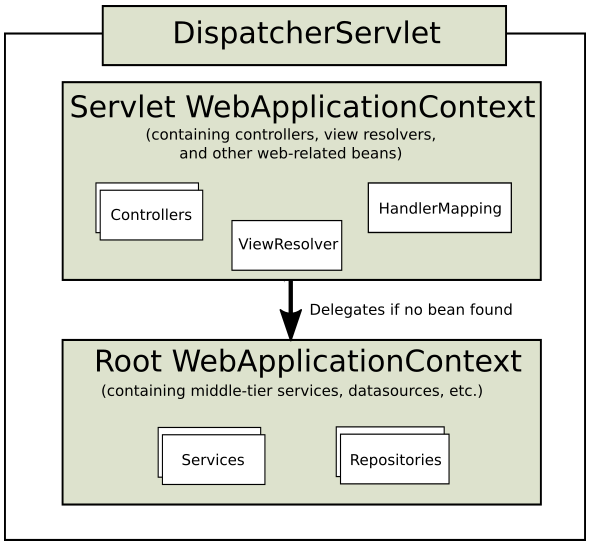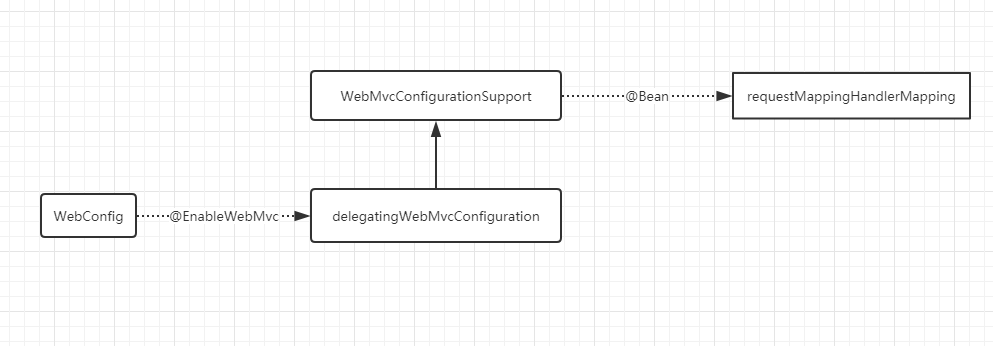Spring系列(六) Spring Web MVC 应用构建分析
DispatcherServlet
DispatcherServlet 是Spring MVC的前端控制器名称, 用户的请求到达这里进行集中处理, 在Spring MVC中, 它的作用是为不同请求匹配对应的处理器, 将结果传递给视图解析器最终呈现给客户端.
前端控制器模式(Front Controller Pattern)是用来提供一个集中的请求处理机制,所有的请求都将由一个单一的处理程序处理。该处理程序可以做认证/授权/记录日志,或者跟踪请求,然后把请求传给相应的处理程序。
Servlet WebApplicationContext 和 Root WebApplicationContext
Spring MVC 存在两个应用上下文, 分别为Servlet WebApplicationContext和Root WebApplicationContext. 他们分别初始化不同类型的bean.
下图来自Spring官方文档

在DispatcherServlet启动的时候, 它会创建Spring上下文Servlet WebApplicationContext, 其中包含Web相关的Controller,ViewResolver,HandlerMapping等.
另外一个上下文Root WebApplicationContext是由ContextLoaderListener创建的, 包含除了Web组件外的其他bean, 比如包含业务逻辑的Service, 还有数据库相关的组件等.
代码(JavaConfig方式的配置代码)
下面是用JavaConfig方式实现的配置代码, 我们先搭建好一个Spring MVC 项目,然后结合源码分析Spring如何注册DispatcherServlet实例的.
// 继承AbstractAnnotationConfigDispatcherServletInitializer并重写其中的三个方法
public class MvcWebAppInitializer extends AbstractAnnotationConfigDispatcherServletInitializer {
// 指定Root上下文的配置类
@Override
protected Class<?>[] getRootConfigClasses() {
return new Class[]{ RootConfig.class };
}
// 指定Web上下文的配置类
@Override
protected Class<?>[] getServletConfigClasses() {
return new Class[]{ WebConfig.class };
}
// url映射
@Override
protected String[] getServletMappings() {
return new String[]{"/"};
}
}
通过重写AbstractAnnotationConfigDispatcherServletInitializer的三个方法完成配置, WebConfig用来配置Web组件, RootConfig用来配置非Web组件.
@EnableWebMvc // 启用MVC
@ComponentScan(basePackages = {"com.xlx.mvc.web"}) // 启用组件扫描,只扫描web相关的组件
@Configuration
public class WebConfig implements WebMvcConfigurer {
// 视图解析器,jsp
@Bean
public ViewResolver viewResolver(){
InternalResourceViewResolver resolver = new InternalResourceViewResolver();
resolver.setPrefix("/WEB-INF/views/");
resolver.setSuffix(".jsp");
resolver.setExposeContextBeansAsAttributes(true);
return resolver;
}
// 重写以启用默认的处理器, 用来处理静态资源
@Override
public void configureDefaultServletHandling(DefaultServletHandlerConfigurer configurer){
configurer.enable();
}
}
@Configuration
@ComponentScan(basePackages = {"com.xlx.mvc"}, excludeFilters = {
@ComponentScan.Filter(type = FilterType.ANNOTATION,classes = EnableWebMvc.class)
}) // 扫描包, 但排除EnableWebMvc注解的类
public class RootConfig {
}
源码分析
Servlet 3.0 旨在支持基于代码的方式配置Servlet容器, 当3.0兼容的servlet容器启动的时候会在ClassPath查找并调用实现了接口ServletContainerInitializer的类的onStartup()方法, Spring中提供了这个接口的一个实现类SpringServletContainerInitializer. 其启动方法的代码如下:
@Override
public void onStartup(@Nullable Set<Class<?>> webAppInitializerClasses, ServletContext servletContext)
throws ServletException {
List<WebApplicationInitializer> initializers = new LinkedList<>();
// 应用中WebApplicationInitializer的bean生成到一个列表中.
if (webAppInitializerClasses != null) {
for (Class<?> waiClass : webAppInitializerClasses) {
if (!waiClass.isInterface() && !Modifier.isAbstract(waiClass.getModifiers()) &&
WebApplicationInitializer.class.isAssignableFrom(waiClass)) {
try {
initializers.add((WebApplicationInitializer)
ReflectionUtils.accessibleConstructor(waiClass).newInstance());
}
catch (Throwable ex) {
throw new ServletException("Failed to instantiate WebApplicationInitializer class", ex);
}
}
}
}
if (initializers.isEmpty()) {
servletContext.log("No Spring WebApplicationInitializer types detected on classpath");
return;
}
servletContext.log(initializers.size() + " Spring WebApplicationInitializers detected on classpath");
AnnotationAwareOrderComparator.sort(initializers);
// 遍历所有WebApplicationInitializer, 并调用其onStartup方法
for (WebApplicationInitializer initializer : initializers) {
initializer.onStartup(servletContext);
}
}
在上面方法的最后, 可以看到其将控制权交给WebApplicationInitializer的实例并遍历调用了onStartup()方法, 而我们定义的类MvcWebAppInitializer 就是它的子类. 完整的继承关系为
WebApplicationInitializer <--
AbstractContextLoaderInitializer <--
AbstractDispatcherServletInitializer <--
AbstractAnnotationConfigDispatcherServletInitializer <--
MvcWebAppInitializer
在类 AbstractDispatcherServletInitializer 中实现了onStartup()方法, 最终调用registerDispatcherServlet()方法完成注册, 两个方法的代码如下:
@Override
public void onStartup(ServletContext servletContext) throws ServletException {
super.onStartup(servletContext);
registerDispatcherServlet(servletContext);
}
protected void registerDispatcherServlet(ServletContext servletContext) {
// 获取Sevlet名称, 这个方法返回了默认值"dispatcher"
String servletName = getServletName();
Assert.hasLength(servletName, "getServletName() must not return null or empty");
// 此处调用的方法是抽象方法, 由子类AbstractAnnotationConfigDispatcherServletInitializer实现, 其最终调用了自定义类的getServletConfigClasses()方法获取配置信息(源码附在本段后面). 用来生成Servlet上下文.
WebApplicationContext servletAppContext = createServletApplicationContext();
Assert.notNull(servletAppContext, "createServletApplicationContext() must not return null");
// 生成dispatcherServlet实例
FrameworkServlet dispatcherServlet = createDispatcherServlet(servletAppContext);
Assert.notNull(dispatcherServlet, "createDispatcherServlet(WebApplicationContext) must not return null");
dispatcherServlet.setContextInitializers(getServletApplicationContextInitializers());
// 注册DispatcherServlet
ServletRegistration.Dynamic registration = servletContext.addServlet(servletName, dispatcherServlet);
if (registration == null) {
throw new IllegalStateException("Failed to register servlet with name '" + servletName + "'. " +
"Check if there is another servlet registered under the same name.");
}
registration.setLoadOnStartup(1);
registration.addMapping(getServletMappings());
registration.setAsyncSupported(isAsyncSupported());
Filter[] filters = getServletFilters();
if (!ObjectUtils.isEmpty(filters)) {
for (Filter filter : filters) {
registerServletFilter(servletContext, filter);
}
}
customizeRegistration(registration);
}
下面附读取Servlet配置类的代码: 类AbstractAnnotationConfigDispatcherServletInitializer实现了createServletApplicationContext(), 可以看到代码中调用了方法getServletConfigClasses(), 这是个抽象方法, 声明为protected abstract Class<?>[] getServletConfigClasses();. 最终的实现正是在我们自定义的子类MvcWebAppInitializer中.
@Override
protected WebApplicationContext createServletApplicationContext() {
AnnotationConfigWebApplicationContext context = new AnnotationConfigWebApplicationContext();
// 读取配置类
Class<?>[] configClasses = getServletConfigClasses();
if (!ObjectUtils.isEmpty(configClasses)) {
context.register(configClasses);
}
return context;
}
上面完成了DispatcherServlet的注册和启动, 接下来可以定义Controller了.
请求映射
在此之前需要了解下关于URL映射的Servlet规范, 注意这是Servlet的规范, 当然也适用于DispatcherServlet, 代码中我们为DispatcherServlet映射为"/", 规范中"/"为使用"default"Servlet, 也就意味着所有的请求默认通过DispatcherServlet处理.
为了处理静态资源, 在WebConfig中覆盖了方法configureDefaultServletHandling()已启用静态资源处理器DefaultServletHttpRequestHandler, 它的优先级是最低, 这意味着在匹配不到其他handler的时候,servlet会将请求交给这个handler处理.
规则按顺序执行,匹配到就直接返回.
- 精确匹配, url完全与模式匹配
- 最长路径匹配, 查找模式中路径最长的匹配项, 例如/user/list/1匹配模式/user/list/, 而不是/user/
- 扩展名匹配
- 默认Servlet
代码
@Controller
@RequestMapping(value = "/home")
public class HomeController {
@RequestMapping(value = "/default",method = RequestMethod.GET)
public String home(){
return "home";
}
}
源码分析
我们的Controller以注解(@RequestMapping,@GetMapping等)方式定义, RequestMappingHandlerMapping用来生成请求url与处理方法的映射关系(mapping),这个mapping最终是由DispatcherServlet调用找到匹配到url对应的controller方法并调用.
通过查看Spring的bean依赖关系图(找到类WebConfig, Ctrl+Alt+U并选spring beans dependency)可以找到RequestMappingHandlerMapping生成的线索.
简化的关系图如下:

可以看到WebmvcConfigurationSupport中有个@Bean注解的方法生成RequestMappingHandlerMapping的实例, 而WebmvcConfigurationSupport继承了DelegatingWebMvcConfiguration, 后者是由@EnableWebMvc注解导入.
/**
*
* 返回排序为0的RequestMappingHandlerMapping实例bean, 用来处理注解方式的Controller请求.
*/
@Bean
public RequestMappingHandlerMapping requestMappingHandlerMapping() {
RequestMappingHandlerMapping mapping = createRequestMappingHandlerMapping();
// 顺序为0, 顺便提一句, 静态资源的处理器Handler的顺序为Integer.Max
mapping.setOrder(0);
mapping.setInterceptors(getInterceptors());
mapping.setContentNegotiationManager(mvcContentNegotiationManager());
mapping.setCorsConfigurations(getCorsConfigurations());
PathMatchConfigurer configurer = getPathMatchConfigurer();
Boolean useSuffixPatternMatch = configurer.isUseSuffixPatternMatch();
if (useSuffixPatternMatch != null) {
mapping.setUseSuffixPatternMatch(useSuffixPatternMatch);
}
Boolean useRegisteredSuffixPatternMatch = configurer.isUseRegisteredSuffixPatternMatch();
if (useRegisteredSuffixPatternMatch != null) {
mapping.setUseRegisteredSuffixPatternMatch(useRegisteredSuffixPatternMatch);
}
Boolean useTrailingSlashMatch = configurer.isUseTrailingSlashMatch();
if (useTrailingSlashMatch != null) {
mapping.setUseTrailingSlashMatch(useTrailingSlashMatch);
}
UrlPathHelper pathHelper = configurer.getUrlPathHelper();
if (pathHelper != null) {
mapping.setUrlPathHelper(pathHelper);
}
PathMatcher pathMatcher = configurer.getPathMatcher();
if (pathMatcher != null) {
mapping.setPathMatcher(pathMatcher);
}
Map<String, Predicate<Class<?>>> pathPrefixes = configurer.getPathPrefixes();
if (pathPrefixes != null) {
mapping.setPathPrefixes(pathPrefixes);
}
return mapping;
}
好了, 现在有了DispatcherServlet, 并且有了可以处理映射关系的RequestMappingHandlerMapping, 接下来再看下当请求到达时, DispatcherServlet 如何为Url找到对应的Handler方法.
DispatcherServlet中定义了处理请求的doService()方法, 最终这个方法委托doDispatch()处理请求, 特别注意中文注释的几个语句, 除此之外, 这个方法还提供了生命周期的一些处理工作.
protected void doDispatch(HttpServletRequest request, HttpServletResponse response) throws Exception {
HttpServletRequest processedRequest = request;
HandlerExecutionChain mappedHandler = null;
boolean multipartRequestParsed = false;
WebAsyncManager asyncManager = WebAsyncUtils.getAsyncManager(request);
try {
ModelAndView mv = null;
Exception dispatchException = null;
try {
processedRequest = checkMultipart(request);
multipartRequestParsed = (processedRequest != request);
// 获取当前请求对应的handler
mappedHandler = getHandler(processedRequest);
if (mappedHandler == null) {
noHandlerFound(processedRequest, response);
return;
}
// 获取当前请求对应handler的适配器
HandlerAdapter ha = getHandlerAdapter(mappedHandler.getHandler());
// Process last-modified header, if supported by the handler.
String method = request.getMethod();
boolean isGet = "GET".equals(method);
if (isGet || "HEAD".equals(method)) {
long lastModified = ha.getLastModified(request, mappedHandler.getHandler());
if (new ServletWebRequest(request, response).checkNotModified(lastModified) && isGet) {
return;
}
}
if (!mappedHandler.applyPreHandle(processedRequest, response)) {
return;
}
// 最终调用Handler的方法
mv = ha.handle(processedRequest, response, mappedHandler.getHandler());
if (asyncManager.isConcurrentHandlingStarted()) {
return;
}
applyDefaultViewName(processedRequest, mv);
mappedHandler.applyPostHandle(processedRequest, response, mv);
}
catch (Exception ex) {
dispatchException = ex;
}
catch (Throwable err) {
// As of 4.3, we're processing Errors thrown from handler methods as well,
// making them available for @ExceptionHandler methods and other scenarios.
dispatchException = new NestedServletException("Handler dispatch failed", err);
}
processDispatchResult(processedRequest, response, mappedHandler, mv, dispatchException);
}
catch (Exception ex) {
triggerAfterCompletion(processedRequest, response, mappedHandler, ex);
}
catch (Throwable err) {
triggerAfterCompletion(processedRequest, response, mappedHandler,
new NestedServletException("Handler processing failed", err));
}
finally {
if (asyncManager.isConcurrentHandlingStarted()) {
// Instead of postHandle and afterCompletion
if (mappedHandler != null) {
mappedHandler.applyAfterConcurrentHandlingStarted(processedRequest, response);
}
}
else {
// Clean up any resources used by a multipart request.
if (multipartRequestParsed) {
cleanupMultipart(processedRequest);
}
}
}
}
上面代码中, 重点关注getHandler方法.
protected HandlerExecutionChain getHandler(HttpServletRequest request) throws Exception {
if (this.handlerMappings != null) {
for (HandlerMapping mapping : this.handlerMappings) {
HandlerExecutionChain handler = mapping.getHandler(request);
if (handler != null) {
return handler;
}
}
}
return null;
}
可以看到请求所需的handler是取自实例变量this.handlerMappings,接下来顺藤摸瓜, 看这个变量是何时初始化的.通过引用, 我们查找到了下面方法.
private void initHandlerMappings(ApplicationContext context) {
this.handlerMappings = null;
if (this.detectAllHandlerMappings) {
// 找到上下文中的所有HandlerMapping, 包括祖先上下文
Map<String, HandlerMapping> matchingBeans =
BeanFactoryUtils.beansOfTypeIncludingAncestors(context, HandlerMapping.class, true, false);
if (!matchingBeans.isEmpty()) {
this.handlerMappings = new ArrayList<>(matchingBeans.values());
// HandlerMapping排序
AnnotationAwareOrderComparator.sort(this.handlerMappings);
}
}
else {
try {
HandlerMapping hm = context.getBean(HANDLER_MAPPING_BEAN_NAME, HandlerMapping.class);
this.handlerMappings = Collections.singletonList(hm);
}
catch (NoSuchBeanDefinitionException ex) {
// Ignore, we'll add a default HandlerMapping later.
// 这个注释...
}
}
// 保证至少要有一个HandlerMapping.
if (this.handlerMappings == null) {
this.handlerMappings = getDefaultStrategies(context, HandlerMapping.class);
if (logger.isTraceEnabled()) {
logger.trace("No HandlerMappings declared for servlet '" + getServletName() +
"': using default strategies from DispatcherServlet.properties");
}
}
}
整理下调用关系: DispatcherServlet initHandlerMappings <-- initStrategies <-- onRefresh <--
FrameworkServlet initWebApplicationContext <-- initServletBean <--
HttpServletBean init <--
GenericServlet init(ServletConfig config)
最后的GenericServlet是servlet Api的.
Spring Boot 中的DispatcherServlet
Spring Boot微服务中的DispatcherServlet装配, 因为其一般使用内置的Servlet容器, 是通过DispatcherServletAutoConfiguration来完成的. 下面是生成DispatcherServlet bean的代码, 这个bean在内部静态类DispatcherServletConfiguration中.
@Bean(name = DEFAULT_DISPATCHER_SERVLET_BEAN_NAME)
public DispatcherServlet dispatcherServlet() {
DispatcherServlet dispatcherServlet = new DispatcherServlet();
dispatcherServlet.setDispatchOptionsRequest(
this.webMvcProperties.isDispatchOptionsRequest());
dispatcherServlet.setDispatchTraceRequest(
this.webMvcProperties.isDispatchTraceRequest());
dispatcherServlet.setThrowExceptionIfNoHandlerFound(
this.webMvcProperties.isThrowExceptionIfNoHandlerFound());
return dispatcherServlet;
}
上面我们通过注解方式构建了一个MVC应用程序, 并且通过源码分析其构建原理, 其中Spring使用的前端控制器实现类是DispatcherServlet, 其在Servlet容器启动的时候实例化, 并初始化容器中的Handler处理器. 当请求到达DispatcherServlet时会调用其doDispatcher()方法选择最合适的处理器. 最后我们扫了一眼Spring Boot的自动装配DispatcherServlet方式.
Spring系列(六) Spring Web MVC 应用构建分析的更多相关文章
- Spring系列(七) Spring MVC 异常处理
Servlet传统异常处理 Servlet规范规定了当web应用发生异常时必须能够指明, 并确定了该如何处理, 规定了错误信息应该包含的内容和展示页面的方式.(详细可以参考servlet规范文档) 处 ...
- Spring系列之Spring常用注解总结 转载
Spring系列之Spring常用注解总结 传统的Spring做法是使用.xml文件来对bean进行注入或者是配置aop.事物,这么做有两个缺点:1.如果所有的内容都配置在.xml文件中,那么.x ...
- 深入理解Spring系列之七:web应用自动装配Spring配置
转载 https://mp.weixin.qq.com/s/Lf4akWFmcyn9ZVGUYNi0Lw 在<深入理解Spring系列之一:开篇>的示例代码中使用如下方式去加载Spring ...
- Spring系列(零) Spring Framework 文档中文翻译
Spring 框架文档(核心篇1和2) Version 5.1.3.RELEASE 最新的, 更新的笔记, 支持的版本和其他主题,独立的发布版本等, 是在Github Wiki 项目维护的. 总览 历 ...
- Spring系列之Spring常用注解总结
传统的Spring做法是使用.xml文件来对bean进行注入或者是配置aop.事物,这么做有两个缺点:1.如果所有的内容都配置在.xml文件中,那么.xml文件将会十分庞大:如果按需求分开.xml文件 ...
- Spring学习(六)-----Spring使用@Autowired注解自动装配
Spring使用@Autowired注解自动装配 在上一篇 Spring学习(三)-----Spring自动装配Beans示例中,它会匹配当前Spring容器任何bean的属性自动装配.在大多数情况下 ...
- Spring学习(六)--渲染Web视图
一.将模型数据渲染为Html 在上一篇文章中,我们所编写的控制器方法都没有直接产生浏览器中渲染所需的HTML.这些方法只是将数据填充到模型中,然后将模型传递给一个用来渲染的视图.这些方法会返回一个St ...
- 【Spring系列】Spring mvc整合redis(非集群)
一.在pom.xml中增加redis需要的jar包 <!--spring redis相关jar包--> <dependency> <groupId>redis.cl ...
- spring入门(六) spring mvc+mybatis
1.引入依赖 <!-- https://mvnrepository.com/artifact/org.mybatis/mybatis --> <dependency> < ...
随机推荐
- ZABBIX监控mysql主从状态
模板如下 <zabbix_export> <version>3.4</version> <date>2018-11-30T08:28:28Z</d ...
- python中的数组和列表
####转自:模式识别实验室主任 #环境win64+anaconda+python3.6 list & array (1)list不具有array的全部属性(如维度.转置等) 代码1: # ...
- AttributeError: Got AttributeError when attempting to get a value for field `password2` on serializer ` UserSerializer`...
Error_msg: AttributeError: Got AttributeError when attempting to get a value for field `password2` o ...
- Ocr答题辅助神器 OcrAnswerer4.x,通过百度OCR识别手机文字,支持屏幕窗口截图和ADB安卓截图,支持四十个直播App,可保存题库
http://www.cnblogs.com/Charltsing/p/OcrAnswerer.html 联系qq:564955427 最新版为v4.1版,开放一定概率的八窗口体验功能,请截图体验(多 ...
- 使用Gradle构建web工程配置详解
- JUC (java.util.concurrent)
1.什么是线程?什么是进程? 2.多线程的状态? public enum State { //6种状态 NEW, RUNNABLE, //可运行 BLOCKED, //阻塞 WAITING, //等待 ...
- "unexpected console statement” in Node.js
.eslintrc.js module.exports = { rules: { 'no-console': 'off', }, };
- Eclipse 设置背景色
window -> preferences -> General -> Editors -> Test Editors -> Background color 勾掉Sy ...
- jsp篇 之 脚本元素
jsp的脚本元素 : 第一种:表达式 (类似输出语句) 表达式 形式:<%= %> 看源码发现[翻译]到java文件中的位置: [out.print(..)]里面的参数. 所以System ...
- [模板] 动态树/LCT
简介 LCT是一种数据结构, 可以维护树的动态加边, 删边, 维护链上信息(满足结合律), 单次操作时间复杂度 \(O(\log n)\).(不会证) 思想类似树链剖分, 因为splay可以换根, 用 ...
